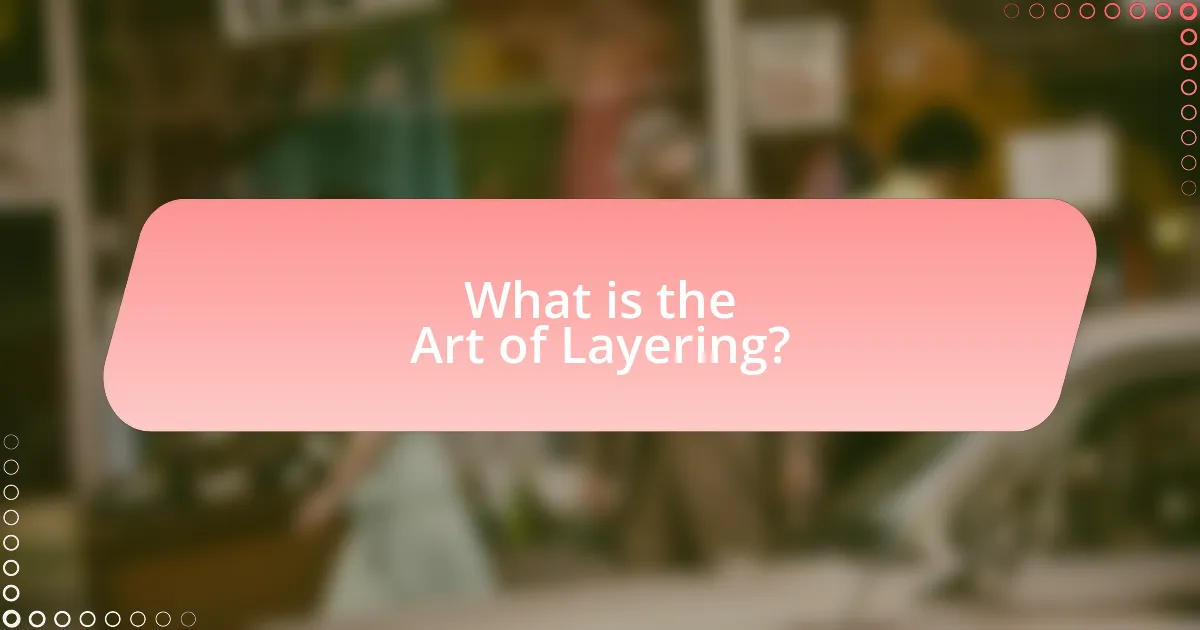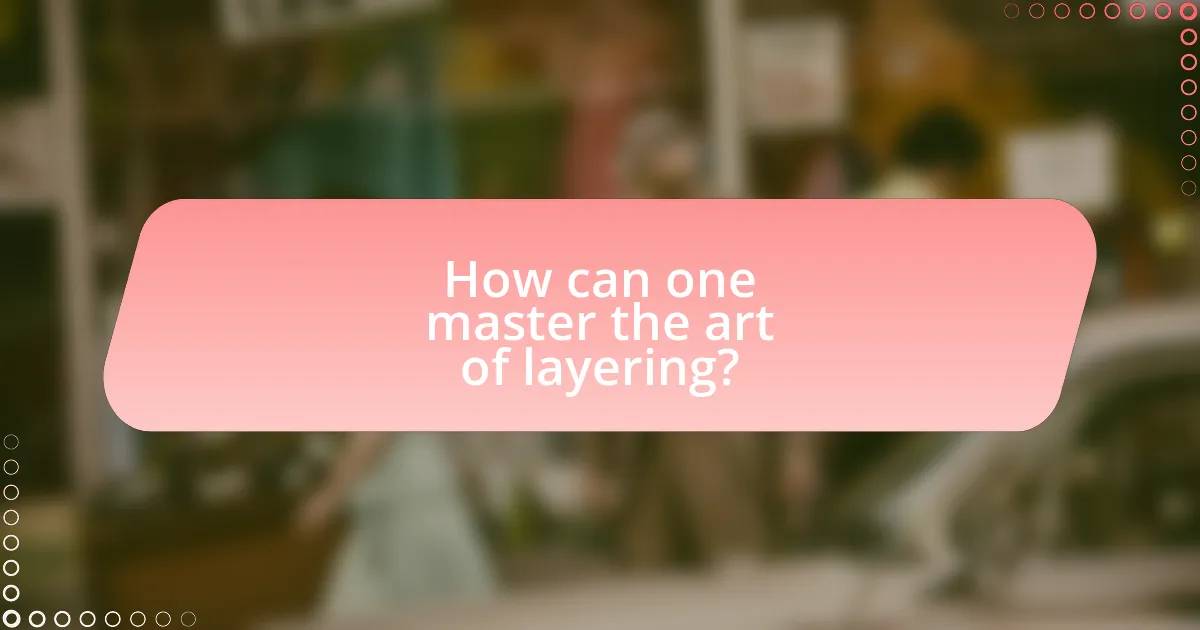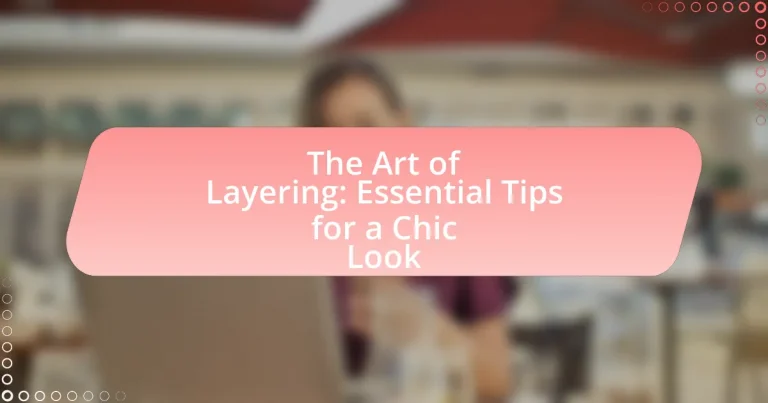The Art of Layering is a fashion technique that combines multiple clothing pieces to create stylish and functional outfits, allowing for adaptability to varying temperatures and occasions. This article explores how layering contributes to a chic look by adding depth and dimension through the strategic combination of textures, colors, and patterns. Key principles of effective layering, such as balance, proportion, and texture, are discussed, along with practical tips for mastering this technique. Additionally, the article highlights the importance of fabric choices, color coordination, and how layering can be tailored for different seasons and occasions, ultimately enhancing personal style and versatility in fashion.

What is the Art of Layering?
The Art of Layering is a fashion technique that involves combining multiple clothing pieces to create a stylish and functional outfit. This method allows individuals to adapt to varying temperatures and occasions while showcasing personal style. Layering can include various types of garments, such as tops, jackets, and accessories, strategically chosen for both aesthetic appeal and practicality. The effectiveness of layering is supported by its ability to add depth and texture to an outfit, enhancing visual interest and versatility.
How does layering contribute to a chic look?
Layering contributes to a chic look by adding depth and dimension to an outfit. This technique allows individuals to combine various textures, colors, and patterns, creating a visually interesting ensemble that stands out. For instance, layering a fitted turtleneck under a loose-fitting blazer not only enhances the silhouette but also introduces contrasting elements that elevate the overall aesthetic. Fashion experts often highlight that successful layering can transform basic pieces into stylish outfits, making it a key strategy in modern fashion.
What are the fundamental principles of layering?
The fundamental principles of layering include balance, proportion, and texture. Balance involves distributing visual weight evenly across an outfit, ensuring that no single layer overwhelms the others. Proportion refers to the relationship between the sizes of different layers, where longer layers can be paired with shorter ones to create a harmonious silhouette. Texture adds depth and interest, as combining various materials enhances the overall aesthetic. These principles are essential for achieving a chic and cohesive layered look.
How does layering enhance personal style?
Layering enhances personal style by allowing individuals to create depth and dimension in their outfits. This technique enables the combination of various textures, colors, and patterns, which can express personal creativity and individuality. For instance, layering a fitted turtleneck under a loose-fitting sweater not only adds warmth but also creates a visually interesting silhouette. Studies in fashion psychology indicate that well-layered outfits can boost confidence and self-perception, as they often reflect a more curated and intentional approach to dressing.
Why is layering important in fashion?
Layering is important in fashion because it enhances versatility and allows for creative expression in styling. By combining different garments, individuals can adapt their outfits to varying weather conditions and occasions, maximizing the use of their wardrobe. For instance, layering can transform a simple dress into a chic ensemble by adding a jacket or scarf, thereby increasing the outfit’s functionality and aesthetic appeal. Additionally, layering can create visual interest through contrasting textures and colors, which is a key principle in fashion design.
What are the benefits of mastering the art of layering?
Mastering the art of layering enhances versatility in fashion, allowing individuals to create diverse outfits suitable for various occasions and weather conditions. This technique enables the combination of different textures, colors, and styles, which can elevate a simple look into a more sophisticated ensemble. Additionally, layering provides practical benefits such as warmth and comfort, as it allows for easy adjustments based on temperature changes. Studies in fashion psychology indicate that well-layered outfits can boost confidence and self-expression, contributing to a positive self-image.
How does layering adapt to different seasons?
Layering adapts to different seasons by allowing individuals to adjust their clothing combinations based on temperature and weather conditions. In colder months, thicker base layers, insulating mid-layers, and protective outer layers are utilized to retain heat, while in warmer seasons, lighter fabrics and fewer layers are preferred to maintain comfort and breathability. For example, during winter, a thermal shirt can be layered under a sweater and topped with a coat, whereas in summer, a tank top may be paired with a light cardigan that can be easily removed. This flexibility in layering not only enhances comfort but also enables personal style expression throughout the year.

What are the key elements of effective layering?
The key elements of effective layering include the choice of base layers, mid-layers, and outer layers, as well as the consideration of fabric types, colors, and proportions. Base layers, typically made from moisture-wicking materials, provide comfort and temperature regulation. Mid-layers, such as sweaters or vests, add insulation and can be made from materials like fleece or wool. Outer layers, including jackets or coats, protect against wind and rain, often utilizing waterproof or windproof fabrics. Additionally, color coordination and varying textures enhance visual interest, while ensuring that each layer fits well and allows for ease of movement is crucial for a polished look.
How do fabric choices impact layering?
Fabric choices significantly impact layering by determining the overall comfort, warmth, and aesthetic of an outfit. Lightweight fabrics like cotton and linen allow for breathable layers, making them ideal for warmer climates, while heavier materials such as wool and fleece provide insulation and warmth for colder conditions. The texture and drape of fabrics also influence how layers interact; for instance, a smooth fabric can slide easily over another, while a textured fabric may create bulk. Additionally, the moisture-wicking properties of certain fabrics can enhance comfort by managing sweat, which is crucial when layering. Thus, selecting appropriate fabrics is essential for achieving both functionality and style in layered outfits.
What types of fabrics work best for layering?
Lightweight and breathable fabrics work best for layering. Fabrics such as cotton, linen, and moisture-wicking synthetics allow for comfortable layering without adding excessive bulk. These materials provide insulation while also enabling moisture management, which is essential for maintaining comfort in varying temperatures. For instance, cotton is known for its breathability, while moisture-wicking synthetics help keep the skin dry. This combination of properties makes these fabrics ideal for creating versatile layered outfits.
How does fabric weight influence layering techniques?
Fabric weight significantly influences layering techniques by determining how garments interact in terms of bulk, warmth, and drape. Heavier fabrics, such as wool or denim, provide structure and warmth, making them suitable for outer layers, while lighter fabrics like cotton or chiffon are ideal for base layers due to their breathability and comfort. The combination of different fabric weights allows for effective thermal regulation and visual interest in layered outfits, as seen in fashion practices where heavier materials are used to anchor the look while lighter fabrics create movement and flow.
What role do colors and patterns play in layering?
Colors and patterns significantly influence the effectiveness of layering in fashion. They create visual interest and depth, allowing for a more dynamic and stylish appearance. For instance, contrasting colors can enhance the separation between layers, while complementary colors can create a harmonious look. Patterns, such as stripes or florals, add texture and complexity, making outfits more engaging. According to a study published in the Journal of Fashion Marketing and Management, the use of varied colors and patterns can increase perceived attractiveness and style coherence in layered outfits.
How can color coordination enhance a layered outfit?
Color coordination enhances a layered outfit by creating visual harmony and cohesion among the different pieces. When colors complement each other, they draw attention to the overall ensemble rather than individual items, making the outfit appear more intentional and stylish. For example, using a monochromatic color scheme or analogous colors can unify layers, while contrasting colors can add interest without overwhelming the look. Studies in fashion psychology indicate that coordinated colors can influence perceptions of style and confidence, reinforcing the idea that well-coordinated outfits are often viewed as more fashionable and put-together.
What patterns are most effective for layering?
The most effective patterns for layering include stripes, plaids, and florals. Stripes create a visual elongation effect, making them ideal for layering under solid colors or other patterns. Plaids offer a classic, textured look that adds depth when combined with other fabrics. Florals can introduce a soft, feminine touch, especially when layered with neutral tones. These patterns are versatile and can be mixed and matched to create a cohesive and stylish layered outfit.

How can one master the art of layering?
To master the art of layering, one should focus on combining different textures, lengths, and colors to create depth and interest in an outfit. Effective layering involves starting with a base layer, such as a fitted top, then adding mid-layers like cardigans or blazers, and finishing with outer layers like coats or jackets. This technique not only enhances style but also allows for versatility in adapting to varying temperatures. According to fashion experts, successful layering requires attention to proportions and balance; for instance, pairing a long tunic with a shorter jacket can create a flattering silhouette.
What are some practical tips for layering successfully?
To layer successfully, start with a base layer that fits snugly against your body, such as a fitted t-shirt or tank top. This foundational piece helps regulate body temperature and provides comfort. Next, add a mid-layer for insulation, like a sweater or lightweight fleece, which traps heat while allowing breathability. Finally, choose an outer layer that protects against the elements, such as a waterproof jacket or coat. This three-layer approach is effective because it allows for easy adjustments based on temperature changes and activity levels. According to fashion experts, layering not only enhances warmth but also adds depth and style to an outfit, making it versatile for various occasions.
How can one create depth with layers?
To create depth with layers, one should combine various textures, colors, and lengths in their outfit. This technique enhances visual interest and dimension, making the overall look more dynamic. For instance, pairing a fitted top with a loose cardigan and a longer coat adds layers that contrast in shape and fabric, which can be visually appealing. Additionally, using a mix of colors, such as a neutral base with vibrant accessories, can further enhance the layered effect. Studies in fashion psychology indicate that varied textures and colors can evoke emotional responses, making layered outfits more engaging to the viewer.
What are common layering mistakes to avoid?
Common layering mistakes to avoid include neglecting proportions, failing to mix textures, and overlooking color coordination. Neglecting proportions can lead to an unbalanced silhouette, as wearing layers that are too bulky or too tight can distort the overall look. Failing to mix textures results in a flat appearance; combining different materials, such as knits with denim or leather, adds depth and interest. Overlooking color coordination can create a disjointed outfit; using a cohesive color palette ensures that layers complement each other visually. These mistakes can detract from the intended chic look that layering aims to achieve.
How can layering be adapted for different occasions?
Layering can be adapted for different occasions by selecting appropriate fabrics, colors, and styles that suit the event’s formality and climate. For casual outings, lightweight layers like t-shirts and cardigans in vibrant colors can create a relaxed look, while for formal events, structured blazers over dress shirts paired with tailored trousers provide a polished appearance. Additionally, seasonal considerations play a role; for winter, thicker materials such as wool or down can be layered for warmth, while summer may call for breathable fabrics like cotton or linen. This adaptability ensures that layering remains versatile and functional across various settings.
What are the best layering strategies for casual outings?
The best layering strategies for casual outings include starting with a fitted base layer, adding a versatile mid-layer, and finishing with an outer layer that provides protection from the elements. A fitted base layer, such as a lightweight t-shirt or tank top, helps wick moisture and provides comfort. The mid-layer, like a cardigan or lightweight sweater, adds warmth and can be easily removed if needed. Finally, an outer layer, such as a denim jacket or a casual coat, offers style and protection against wind or light rain. This approach not only ensures comfort but also allows for easy adjustments based on changing temperatures, making it practical for various casual settings.
How can layering be styled for formal events?
Layering for formal events can be styled by combining tailored pieces such as blazers, vests, and dress shirts to create a polished look. This approach allows for versatility in temperature control and adds depth to the outfit. For instance, a fitted blazer over a crisp dress shirt paired with tailored trousers can elevate the overall appearance, while a lightweight vest can add sophistication without bulk. Additionally, incorporating textures like silk or wool can enhance the visual interest of the ensemble, making it suitable for formal occasions.
What are the best practices for achieving a chic layered look?
To achieve a chic layered look, focus on combining different textures and lengths while maintaining a cohesive color palette. Start with a fitted base layer, such as a turtleneck or a fitted tee, and add varying lengths of outer layers like cardigans, blazers, or oversized jackets. Incorporating accessories like scarves or statement necklaces can enhance the layered effect. Additionally, balancing proportions is crucial; for example, pair a long tunic with tailored pants to avoid overwhelming the silhouette. This approach is supported by fashion experts who emphasize the importance of layering for versatility and style, making it a staple in contemporary fashion.


